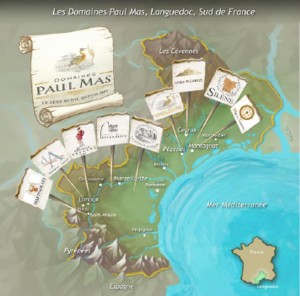All posts by Barbara Payne, Editor
Sexy – and practical – way to carry
Not talking about a concealed weapon, ladies, though I guess you could. But for hands-free carrying your flask or phone, credit card, cash and key without lugging a bag, try this very cool new item called SmarterGarter. The makers were kind enough to send a sample, and I’m impressed. As you’ll see from all the online photos, this new-fangled cache comes in multiple colors/designs (there’s even one with metal studs!) and looks mucho lady-macho on your thigh or your boot top. It also meets the new entrance regs for NFL games (no purses bigger than a hand-sized clutch and no butt bags).

And for those of you thinking, wow, those models on the website are all very thin. Will it fit me? I’m here to tell you, the large size fits a generous thigh nicely. Made with hooks on strong elastic (just like many bras), you can connect the hooks while it’s lower on your leg (at the calf), and then slide it up your leg until it’s comfortable. I like the feel of the vegan leather and the fact that the closures are magnetic. I hate trying to locate and close snaps, don’t you? The material on the inside assures that it stays firmly in place, too. What more can you ask?
Use one of these when you’re out clubbing/dancing, attending a festival, game or wine tasting (where you’re already trying to balance the tasting notes book and a pen, the food and the wine glass), traveling, hiking, or riding your, ahem, motorcycle. The SmarterGarter can hold many types of useful stuff…
- flask (small round, taller rectangular)
- smart phone (yes, it even fits the new iPhone 6 PLUS)
- ID (driver’s license, business cards)
- keys (home, hotel rooms, locks)
- safety (Mace, pocket knife, condom)
- comfort (tampon/pad, tissues)
- beauty (small comb, lipstick, compact, nail file)
- medical (medications, insulin pump, epi pen)
- travel (passport, tickets, map, guide)
- money (cash, check, credit cards)
- miscellaneous (pen, small notepad, flash drive)
- kid stuff (diaper, wipes, pacifier)
Food and drink drew 400 to Uptown Uncorked
An event called Uptown Uncorked, traveling around to major cities in the U.S., is the result of an interesting partnership among Lexus luxury cars, Diageo fine spirits people, and Uptown Magazine for upscale African American consumers.
For its recent Chicago showing, organizers invited two rising African American chef stars and two African American wine aficionados (The McBride Sisters) to provide the goodies, and everybody got to show off their products to a group of 400 enthusiastic members of their target market. It was a huge gathering, with loud pumping music, and lines of people waiting to pick up their samples of food
and wine. Lexus provided the spotlight adornments in the form of some of their latest models set up in the cool space at Moonlight Studios, 1446 W. Kinzie.
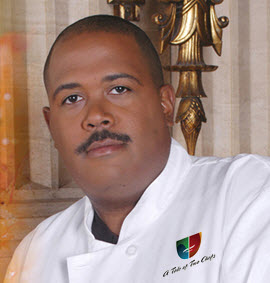
One of the evening’s master chefs, Chef Julius Russell is not only a private chef to celebrities but also serves as owner of A Tale of Two Chefs, Culinary Ambassador to Chile, and as a TV Host on the Big Ten Network. As a private chef, Russell provides everything from in-home cooking for the family to large scale catering for public events. He focuses heavily on authenticity, using ingredients and techniques specific to each of the regions he has traveled. Chef Julius says, “I’m just a shy guy who likes to cook.”
What a neat way to create synergy between brands and attract a crowd of folks who appreciate your wares.
Related articles
Book review: Vintage by David Baker
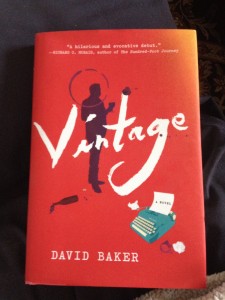
You’ll either be delighted or affronted by the protagonist of Vintage by David Baker–possibly both. Bruno Tennenbaum is a half Jewish/half Catholic, working-class gourmet food writer with a weakness for expensive wines and indulgent meals–and has a not-so-surprising resemblance to certain qualities of the author himself.
Unfortunately, protagonist Bruno’s excesses have come back to haunt him–a recent over-indulgence in wine has left him broke, fired from his job as a food columnist at the Chicago Sun-Times, and nursing a spot on his mothers couch. He’s separated from his wife and two daughters–though he still visits occasionally and charms them by cooking fabulous meals and bringing special wines–and he’s lost as to how to turn things around.
Eataly hosts Piemonte Italian red wines
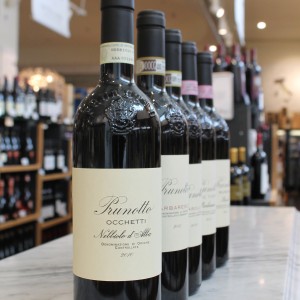
Eataly Chicago is dedicated to providing a full schedule of educational programs around food and wine. A recent event featured wines by Prunotto, the Antinori family’s picturesque wine estate among the Langhe hills of the Piemonte region of Italy (located in the southern section of the cuff of the Italian boot-shaped land mass).
Signor Emanuele Baldi, representing the brand, said Prunotto made the Italian wine map after the Antinori family, with 600 years of wine-making fame in Tuscany and Umbria, turned its attention to Piemonte (aka/Piedmont). He presented a small array of tannic reds from the area: Barbera, Barbaresco, and Barolo, all paired with complimentary dishes from the chef at Eataly’s cucina.
First course, served with the Barbera and the Barbaresco wines was Vitello tonnato—melt-in-your-mouth-tender, palest-pink poached veal with a smooth, creamy tuna and caper sauce—delightful, light and piquant with a drizzle of fresh lemon to set it off. The second course consisted of a platter of salumi and formaggi, tidbits of succulent preserved meats and rich, smooth cheeses also from the
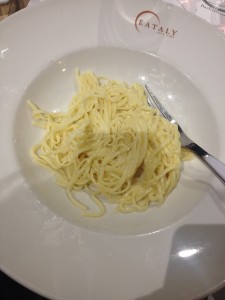
Piemonte region. He pointed out that eating any blue cheese with tannic wines is always problematical; the only cheese, he said, that can reliably go with almost any wine is classic Parmigiano. The third course was a beautiful nest of egg-rich noodles covered in a butter sauce perfumed with white truffle essence. Delicious.
The Barbera Pian Romualdo D’alba DOC 2012 with a ruby a color was representative of the high acidity of this variety of grapes as grown here in clay soils layered with sand and seashells. Here, these grapes tend to produce wines that are fresh-tasting with more fruit and more acidity. This particular wine improved with time after opening, gradually smoothing out some of what many Americans would perceive as sharpness.
The two Barbaresco wines, both DOCG appellations (the highest designation in Italian winemaking), included Prunotto Barbaresco 2011 and Prunotto Bric Turot 2008. Each had a beautiful garnet color which he said they would always have, no matter how long you age them. They show more delicate floral than fruit and are considered more feminine and are made with Nebbiolo grapes, grown only in Piemonte. Wines made with Nebbiolo grapes show elegance and finesse similar to what Americans find in Pinot Noir varietals. Good with pasta, stewed meat, roast duck and others.
The two Barolo wines, both also DOCG appellations, included Prunotto Barolo Classic 2009, and Prunotto Bassia Barolo 2008. These two, also made with Nebbiolo grapes, were the deepest and richest wines of the evening. The presenter described them as more muscular, with higher tannins and greater structure, not unlike Cabernet Sauvignon wines from America. Excellent paired with the rich, buttery noodle dish. Each of these is a perfect companion to a variety of salumi, meats and cheeses.
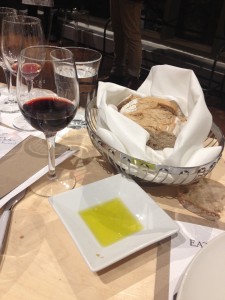
It was a pleasure to hear the presenter give a famous Italian maxim, “The best wine is the one whose bottle is empty first.” So, if you’re one who says, “Hey, I just know what I like,” that means your opinion matters as much as any expert’s.
By the way, their website is surprisingly easy to use. For more information, visit the Prunotto website.
Getting kids to snack healthier – New product is sweet and portable
Kids. They don’t even know when they’re hungry half the time because they’re so busy growing and learning they forget to eat. Making sure they get enough nutrition is always a challenge.

According to the US Center for Disease Control and Prevention, the rate of childhood obesity has more than doubled in children and tripled in adolescents within the last 30 years. And the culprits are easy to figure out: too many pre-packaged, sugar-or-corn-syrup-laden, fatty, high-calorie foods instead of nutritionally dense foods (whole grains, fruits, vegetables, etc.)—the same problem a lot of adults have.
But in this modern, high-stress, no-time-to-cook world, what’s a busy working parent to do? I was intrigued when offered a sample of a new product created by a couple of moms who worried about what their kids were snacking on. The pouches are called Slammers Snacks, and they meet a busy parent’s needs as well as many kid preferences: screw-top, portable snack pouches (shaped like little old-fashioned hot-water bottles) that list organic fruits and vegetables as main ingredients (full list of ingredients below**). Labels say little or no fat plus 60 to 70% of daily vitamin C requirement. Other vitamin and mineral contents depend on the specific fruits/vegetables in each flavor mix (e.g., mango is big on vitamin A). A big selling point for two of their newest flavors is that each also contains seven grams of protein—read the label to make sure you’re getting a protein-boosted flavor.
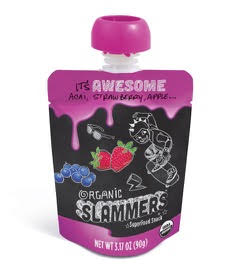
Because without the protein, a potential downside is that they’re high in carbs and sugars because of all the fruit juice concentrates. Calories vary greatly—140 in the “Protein+ Organics Pomegranate Grape Crush” because protein powder boosts the calories, and 70 for the “It’s Epic Orange, Mango & Yogurt.” The concentrated fruit sweetening seems to be the tradeoff to get kids to eat it.
Taste is not overly sweet (no sugar added) and varies by the types of fruits used. The texture is smooth and soft like thin baby food. Or like a thicker version of the protein-powder smoothies muscle-building experts recommend.
The real test, of course, is whether kids eat them. I gave my 8-year-old granddaughter a couple of these squeezable, suckable pouches in flavors of Pomegranate Grape Crush and Orange, Mango & Yogurt. She ate them and is open to more. That’s a thumbs-up in my book—although thank goodness she still likes fresh fruit and vegetables (the very best road to kid nutrition).
You’ll find these pouches at Target, Safeway, Publix, H-E-B, Ralphs, The Market, Tom Thumb, Randall’s, Carr’s, Eagle and Vons. Targets in the Chicago area that carry Slammers: 7100 S. Cicero Ave., 2656 N. Elston Ave., 4433 S. Pulaski Rd., 1154 S. Clark St., 6525 W. Diversey Ave., 1940 W. 33rd St., 2112 W. Peterson Ave., 11840 S. Marshfield Ave., 1200 N Larrabee St., 1101 W. Jackson Blvd.
**Ingredients listed on a pouch of Slammer Snacks Pomegranate Grape Crush Protein+:
Organic apple, organic banana, water, whey protein isolate (Eating Well magazine says this powder can help build muscles and keep you lean), coconut cream, grape juice concentrate, organic pomegranate juice concentrate, purple carrot juice concentrate, organic lemon juice concentrate, ascorbic acid. 1g saturated fat, 26g carbs, 1g dietary fiber, 19g sugars, 7g protein.
Japan’s new Scotch-type whisky surprises and delights
Japan is known, among many other things, for its delicate paintings and its impressively ritualistic tea ceremony. But seldom in the U.S. for its whiskies.
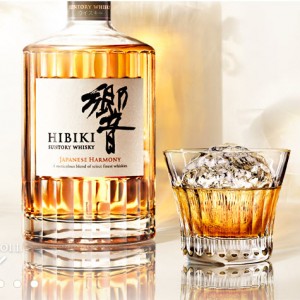
Recently at a lovely modern venue in West Loop known as Morgan’s on Fulton, the Beam Suntory company showcased this latest innovative liquor. Packaged in a beautiful cut-glass decanter with 24 cuts to match what the Japanese know as 24 seasons, this light, delicate, oaky (it’s aged in 5 different types of casks) but harmoniously blended whisky is likely to bring a smile to the face of Scotch lovers and bourbon lovers as well as whiskey lovers. It’s delicate without being the least bit fragile (aromas of rose, lychee, rosemary and sandalwood, and notes of sweet candied orange peel and white chocolate on the palate). And it worked beautifully in several mixed cocktails served at the event. And then, Japanese attention to detail was apparent in the way the whisky was presented unmixed—with a hand-carved ball of pristinely clear ice in each glass. This method preserves the flavor and aroma by preventing too much melting to dilute the liquor–and it looks really cool. They make the ice in large square cubes, and the bartender hand-chips it into a ball.
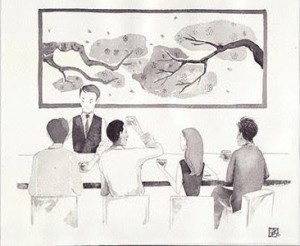
It’s a beautiful sight, the glistening super-clear ice in the pale honey-amber-colored whisky. But they set it off even more by presenting a multimedia, interactive visual display known as the Hibiki® Japanese Harmony™ Bar. This fully immersive, interactive experience is the first of its kind in the world. It takes guests on a journey through the richness of the Japanese seasons, the moving pictures of paintings (all by famous Japanese artist Shinsuke Kawahara) activated by each of eight participants picking up his or her glass and swirling it. Fluttering butterflies in spring and leaves in fall, snowflakes in winter and flowers and sunshine in summer. Each season was accompanied by appropriate Japanese-tinged musical interludes. The lights in the room were turned down so the visual presentation took center stage.
Tomatoes star in super dinner at Osteria via Stato
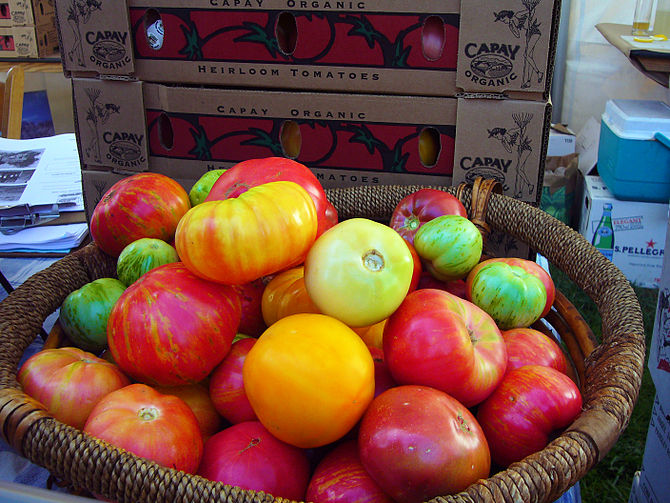
The name of this place, Osteria via Stato, was familiar enough. But I hadn’t heard anyone raving about it, or really even talking about it. So it was under my radar for a long time. Through a friend recently, heard about their Heirloom Tomato Dinner. Sounded great (and at $75 per person including wine pairings, definitely not overpriced by Chicago standards, so we signed up. And what a delightful discovery.
Even from outside it looked promising. The patio was fairly busy on a warm Wednesday evening, plenty of outdoor diners smiling and looking very comfortable. Then inside, the welcoming began in earnest. The whole place is full of dark wood and soft lighting—perfect ambiance in my book. The friendly concierge helpfully pointed out the ladies’ room and then the door to the private room where the Heirloom Tomato surprises awaited. In the room, amiable-looking folks mingled and sipped wine or little tomato-based, sweet-and-spicy cocktails invented for the occasion, and servers bustled efficiently around doing last-minute prep.
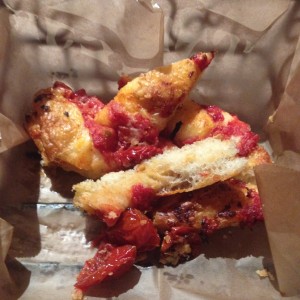
Antipasti, both passed and served at table, set the stage. Delicious little bites – oh, how creamy the Gorgonzola cheese melting under the square of crisp bacon on one—preceded the family-style platters of heirloom tomatoes nestled in marinated rings of Tropea (Italian red) onion and crowned with hand-made Italian Buffalo Mozzarella (SOOO good), big plates of Pappa al Pomodoro (local tomato and bread soup – num!), and super-thin-crusted pizza of Creminelli Coppa (Italian cured meat similar to prosciutto), roasted tomatoes and Pecorino cheese. Oh, yes and baskets of fluffy-inside, crusty-outside Italian bread and moist, salty slices of tomato-adorned focaccia always on the table, along with the roasted-garlic olive oil and dishes of olives. The pairing was a delicious Soave Pieropan 2014.
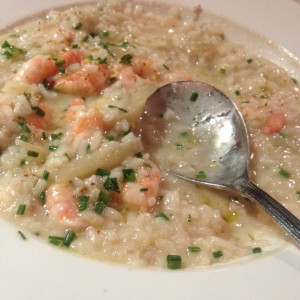
Okay, now we get to the primi (first course). Utterly lovely, light and creamy risotto made with Laughing Bird Shrimp from Belize and laced with chunks of fennel and flavored lightly with tomato. Simply excellent. We both wanted to keep eating this one.
The wine that came with the secondi deserves a whole paragraph to itself. The Tormaresca Trentangeli 2012 was extraordinary—rich-hued, velvety in the mouth, and deeply gratifying to the palate with a long, smooth finish. A perfect companion to the food. I dream of acquiring a case of this in the hopefully near future. What a surprising treat as your next hostess gift (see earlier post about Antinori wines) – and if Wine Searcher is on target, a bargain in the price range of $15.
Well, and finally we come to the Dolce. I am not usually a dessert person, but I simply had to try each one of the specialties on offer here. Gelato, which I normally can live completely without, was so flavorful, creamy and rich that I had to try several flavors, each more lovely than the one before. The cookies—sandy-sweet wafers sandwiched with fabulous chef-made heirloom tomato jam, slices of almond-studded chocolate-covered soft crackers, and dark chocolate truffles dipped in powdered sugar—were impossible to resist. And the fact that the server brought over a slender chocolate bar wrapped in heavy paper and smashed it with a hammer to break it into smaller pieces made it seem impolite not to try some chocolate—lovely. Of course, the pairing of Saracco Moscato d’Asti 2013 made a bubbly light companion to these indulgences.
Congratulations to Chef David DiGregorio and his crew for taking the treasures of the earth lovingly grown by Nick Nichols of Nichols Farm & Orchard and transforming them into dishes fit for the gods. And thank you to Nick Nichols for investing the love and labor to coax these gems from the earth against all weather and natural odds. In case you’re interested, Nichols Farm has a CSA (community support agriculture that delivers fresh vegetables to Chicago and suburbs).
And thank you to the excellent servers and helpers at Osteria via Stato. They were efficient and gracious and helpful in every way.
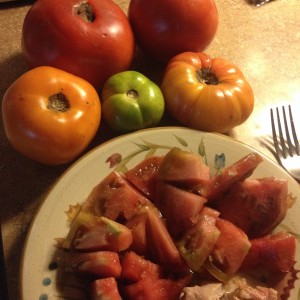
Portuguese Wines of Tejo have big appeal
Portugal. Home of port wine, right? Yes, but also home to many beautiful table wines as well. Master Sommelier Eric Entrikin from California recently presented an array of samples from Wines of Tejo at the beautiful Sepia Restaurant private dining space.

Entrikin said that even though grapes indigenous to Portugal have very different names from the ones most Americans are familiar with, they possess categorical similarities. He explained how, during his formal training as a sommelier, he had to learn to taste all over again. He learned to sense and taste similarities between types of wines that are made from different grapes yet have distinct features in common. For example, Alvarinho grapes from Portugal produce wines with similarities to those made from Albariño grapes from Spain and to some wines made with Chardonnay grapes. Aragones grapes in Portugal are known as Tempranillo in Spain and produce wines that might compare to some of those made from Pinot Noir grapes.
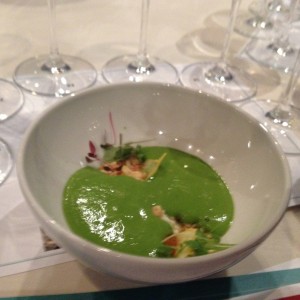
The white wines presented were exceptional in flavor and remarkably value priced, most ranging from ~$9.99 a bottle to $13.99. Sepia chefs did an admirable job pairing dishes with these lovely wines. For example, with the first course of super-creamy, zucchini-fresh-basil gazpacho studded with burrata and garnished with Marcona almonds, three very different types of dry white wines each complemented the dish in a uniquely enjoyable way.
Favorite white wines included the complex but beautifully balanced Quinta da Ribeirinha 2014 Vale de Lobos Branco–an incredible value at ~$10.99–and the Quinta da Aloma 2014 Arinto VR Tejo–bright and crisp and delightful in a multitude of ways (think Sauvignon Blanc without as much minerality) and well worth its ~$9.99 price tag. I kept going back to taste this one because I felt like I discovered something new with each taste.
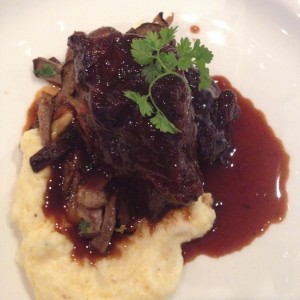
Several rich red wines were selected to accompany a red-wine-braised pork cheek (bearing some resemblance to a chunk of braised beef) that was served artfully with a smoked mushroom escabeche atop a smear of creamy polenta and garnished with tiny sprigs of fresh herb. Notable values among the reds included Casal Branco 2012 Quinta do Casal Branco Tinto (~$10.99) and Adega Cooperativa do Cartaxo 2012 Bidao Classico Tinto (~$8.99).
The imaginative food items paired so well with the delightful, delicious Wines of Tejo–and served in such lovely surroundings–that this was an occasion to remember. Visit Sepia soon, and talk to your favorite wine merchant to seek out some of these exceptional Portuguese values. You will not regret it.
Read more about some of the luscious wines from another region of Portugal, the Duoro River Valley.
Related articles
French winemaker surprises with affordable luxury wines
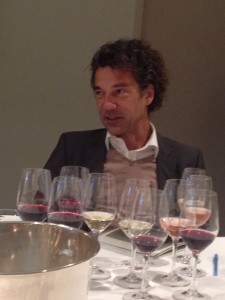
Jean-Claude Mas is a tall, handsome, slender Frenchman who has earned a respected place among experts in the wine world as the leader of Domaines Paul Mas. He said while in Chicago recently that he never grows tired of talking about his wines because he doesn’t talk about the technical side. He speaks from his heart about the emotional side of winemaking.
He spoke with obvious pleasure and pride about the wines he’s been creating in Languedoc since 2000. His deep enthusiasm for the process and the joys of making wine, tasting wine, and enjoying wine with friends and customers came through as he spoke with passion about his dedication to creating “everyday luxury” for wine consumers.
Domaines Paul Mas is a leading wine producer from the South of France. At it since 1892, the Mas family bequeathed 35 hectares of vines in Languedoc to Jean-Claude Mas in 1998, and he has taken the reins with gusto and imagination far beyond where the family had previously gone. Now owner and producer, Jean-Claude Mas takes full advantage of the many variations on Mediterranean climate and the wide array of terroirs available in the region by establishing ten separate vineyards.
He makes the most of each location by hiring winemakers who have the technical skills needed and who share his commitment to sustainable growing practices, while he himself makes the critical decisions: when to pick the grapes and so on. His portfolio of fine-yet-affordable wines has been instrumental in propelling forward what many call the “new Languedoc” or the “new wave” of French wine.
The Mas culture and philosophy is called “luxe rural” because, he says, “we cherish our rural roots, we strive for excellence in everything we do. Our wines are the end result of our desire to delight and thrill.” And yet, he makes a point of honor that almost all of his retail wine prices be kept under $20 US–the point at which many buyers begin to question value for dollars.
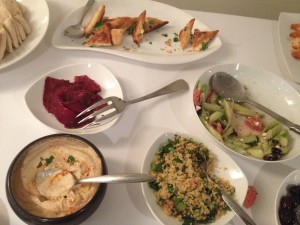
As proof, almost all of the wines showcased at Naha restaurant, 500 N. Clark St. were extraordinary and yet are available at that mark of under $20. The wines were a treat for the palate, and the elegant table setting in the downstairs private dining room at Naha was a treat for the eyes, while the imaginative American-and-Middle-Eastern-inspired tapas made delicious satellites to the starring wines.
It’s not easy choosing memorable wines from among the thousands of possibilities. But based on this tasting, you should be able to choose almost any wine from one of the Domaines Paul Mas estates and be sure you’ll get a highly drinkable fine wine. One thing you could do is have this list with you when you speak with your wine merchant. Pick the varietal you’re in the mood for and ask for a bottle from one of these ten estates (see photo of map below):
- Château Paul Mas, Clos de Savignac & Clos des Mûres, Montagnac;
- Domaine Silène, Saint Pons de Mauchien;
- Château Paul Mas, Conas & Clos de Moulinas, Pézenas;
- Mas des Tannes, Montagnac;
- Château Teramas Astruc, Malras;
- Château Arrogant Frog, Gaja et Villedieu;
- Château de Martinolles, St Hilaire;
- Château Crès Ricards, Ceyras;
- La Ferrandière, Aigues-Vives; and
- Château Jérémie, Fabrezan.
